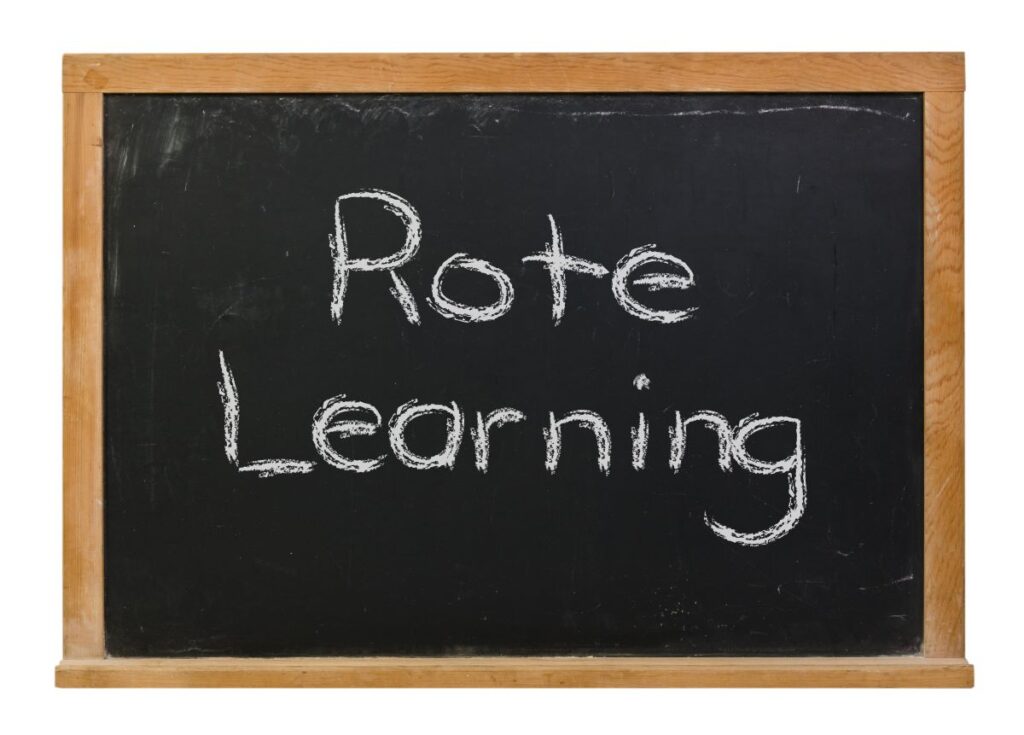Rote learning – a memorization technique based on repetition – has been a traditional teaching method for centuries. This method repeats information until you’ve memorized it without necessarily understanding a concept.
You may recall using this technique when you were in school and were asked to write your spelling words down on paper five times each or practice your multiplication tables repeatedly.
In today’s education system, there’s been an ongoing debate about whether rote learning still has a place in 21st-century education. Here, we’ll look at the pros and cons and see whether rote learning is an outdated technique or if it has a valid place in today’s classrooms.
What Is Rote Learning?
Rote learning is a technique teachers use to commit information to their students’ memory. This method, also known as memorization or “drills,” involves repeating information again and again until the student can recall the information without any difficulty.
The goal is to memorize information such as facts, concepts, lists, vocabulary, procedures, or factual knowledge. It can be used to teach spelling rules or grammar, arithmetic operations or formulas, new words or meanings of words, poems, speeches, or passages of text.
Rote learning differs from other types of learning because it relies on memorization and repetition, whereas other learning approaches focus on understanding concepts or principles.
Different approaches may encourage critical thinking, use problem-solving skills, or challenge students to apply knowledge to real-world situations or be innovative to foster a deeper understanding of a concept.
The Benefits of Rote Learning
Rote learning is most effective when the primary goal is to memorize and recall specific information such as dates, facts, or figures. It can also be beneficial when learning music scales or chords, terminology, or historical dates. Here are a few more advantages of rote learning and rote learning examples.
Helps Memorization
Rote learning relies on repetition, so when you repeatedly review information, the repetition will strengthen your memory.
When students memorize math facts or spelling words, it will stay in their short-term memory. However, the more they recite these facts or words, the better the chance it will become stored in their long-term memory.
A Quick Way to Acquire Knowledge
Rote memorization is great for students to learn quickly because of its repetitiveness. Since students are reviewing and reciting information repeatedly, it reinforces their retention, making it easier to recall information. This approach is quite effective when students need to recall something like their telephone number or address without hesitation.
Builds a Foundation of Knowledge
Many teachers like to use rote memorization as a foundational tool to help students learn facts or vocabulary in the early stages of learning.
Since this approach focuses on repetitive memorization, it can help lay the groundwork for understanding more complex information. For example, mastering the alphabet, multiplication tables, historical dates, or facts can be learned through rote memorization before diving into more advanced levels of learning.
Can Boost Students’ Confidence
One of the great benefits of rote learning is the boost of confidence students get when they can recall information accurately. When students can recall details effectively for exams or presentations, it serves as a confidence booster, reducing test-related anxiety and strengthening their self-esteem.
The Drawbacks of Rote Learning
The flipside of rote learning is that it’s not very popular. Many people believe it discourages students from using their creativity, and since it tends to be monotonous, students lose interest easily, hindering them from developing new skills.
Relying too heavily on rote learning can also limit a student’s understanding of a concept. Here are a few more disadvantages of using the rote learning method.
Information Retained Is Only Short-Term
One primary limitation of rote memorization is the information retained is only temporary. One study revealed that when students use rote learning to memorize information, the information is only temporarily stored in their short-term memory, so after they pass an exam the information is lost and will not help them in future challenges.
Focuses Too Much on Memorizing Information
Rote learning prioritizes recalling facts or details instead of understanding concepts or applying critical thinking skills. While it may be useful to memorize information in some instances, using this approach too often may lead to students having a lack of ability to think critically or to problem-solve.
Can Lead To Stress and Anxiety
The amount of time that is required to memorize large amounts of information in a short time can be stressful and lead to anxiety, especially when it involves remembering information repeatedly until it is committed to memory.
Additionally, students may fear forgetting the information as well as fear they won’t perform well on a test if their grade depends on memorizing facts accurately.
Doesn’t Always Challenge Students
Today’s classrooms aim for students to be meaningful thinkers and challenge what they are learning or prove where they got their answer. In rote learning, the answer is provided for the students, so there is nothing to prove; it doesn’t challenge their brain.
Rote Learning in the Modern World
What role does rote learning play in education today? While it may not be the most popular learning approach in schools today, it still does have a place in the classroom. It can be effective for memorization tasks like learning times tables or basic vocabulary words.
It can help youngsters memorize the alphabet or learn their phone number and address. However, in today’s classrooms, modern education emphasizes critical thinking and problem-solving skills.
While rote learning can help lay the foundation, it must be used in conjunction with more interactive and innovative learning methods that help spark students’ creativity so students can gain a deep understanding of complex concepts.
Rote learning remains an effective learning approach. However, its role in today’s classrooms is evolving. To prepare students for the complexities of the future, a balanced approach that integrates both rote memorization and 21st-century skills that emphasize a deeper understanding of concepts is needed for students to thrive in today’s world.
You’ve got important career goals — we have the graduate program to get you there. Check out our available graduate degree programs to advance your career today!




